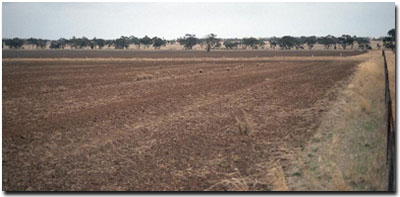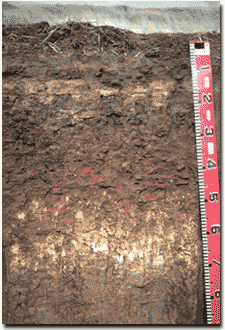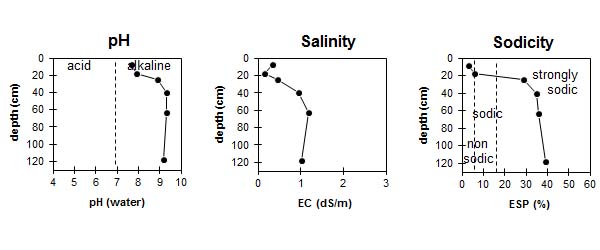Site LS15
Location: Netherby
Australian Soil Classification: Hypercalcic, Hypernatric, Red SODOSOL
Northcote Factual Key: Db 1.33
Great Soil Group: solonetz
General Landscape Description: Upper slope on the northern spur of a subdued north-south trending rise. Slopes are generally 2-3%.
 LS15 Landscape |
Soil Profile Morphology:
Surface Soil
| A1 | 0-15 cm | Dark brown (10YR3/3); sandy clay loam; weakly structured; weak consistence dry; pH 7.7: |  LS15 Profile |
| A2 | 15-20 cm | Reddish brown (5YR4/4) sporadically bleached; sandy clay loam; strong consistence dry; pH 7.9; clear change to: | |
| Subsoil | |||
| B21 | 20-30 cm | Reddish brown (7.5YR4/4); medium clay; strong medium to coarse prismatic, parting to strong medium blocky structure; strong consistence moist; pH 8.9: | |
| B22 | 30-50 cm | Dark red (2.5YR3/6); heavy clay; moderate medium prismatic, parting to strong medium blocky structure; very strong consistence dry; pH 9.3: | |
| B23 | 50-75 cm | Yellowish red (5YR5/6); light medium clay; structure similar to above; firm consistence moist; contains many (20 - 50%) soft calcareous segregations; pH 9.3: | |
| B24 | 75-160 cm | Light yellowish brown (10YR6/4) with yellowish brown (10YR5/8) and strong brown (7.5YR4/6) mottles; sandy clay; moderate coarse prismatic, parting to coarse polyhedral structure; strong consistence moist; pH 9.2: | |
| C | 160+ cm | Weathered sandstone. | |
Key Profile Features:
- Strong texture contrast between surface (A) and subsoil (B21) horizon.
- Hardsetting nature of surface soil.
Soil Profile Characteristics:
pH | Salinity | |||
Surface (A1 horizon) | Slightly Alkaline | Low | Non-Sodic | None |
Subsoil (B21 horizon) | Strongly Alkaline | Low-Medium | Strongly Sodic | Complete |
Deeper Subsoil (at 1 metre) | Very Strongly Alkaline | High | Strongly Sodic | Complete |

| The surface soil is strongly acid. The subsoil becomes very strongly alkaline at depth. | The salinity rating is low in the surface. The subsoil is low becoming high with depth. | The surface is non-sodic. The subsoil is strongly sodic. |
Management Considerations:
Surface (A) Horizon
- Building up organic matter levels will assist in improving soil fertility, water holding capacity and aggregate stability. Practices such as residue retention, minimum tillage and including pasture rotations should be utilised if cropping occurs.
- The subsurface (A2) horizon seems to be developing a cultivation pan layer, which may restrict root and water movement. This horizon is also slightly sodic. Mechanical disturbance (e.g. cultivation) when in a moist to wet condition is likely to promote the development of a cultivation pan (as indicated by dispersion occurring after remoulding).
Subsoil (B) Horizons
- The strongly sodic and dispersive subsoil is likely to restrict water and root movement at 20 cm and below. The sporadic bleaching that occurs above this horizon shows that water movement is being restricted by the subsoil. Deep ripping with gypsum application has been advocated by some researchers as an ameliorative technique for sodic subsoils. A test strip could be used to assess likely benefits. Ripping should not be carried out, however, if the soil is in a moist to wet condition.
- Subsoil salinity levels are likely to affect sensitive species from 30 cm depth in the profile.
- The subsoil from 30 cm is strongly alkaline. This indicates that some nutrients (e.g. iron, manganese, copper and zinc) may be poorly available to plants at depth. Plant tissue analysis can be used to determine if difficulties occur.
- Superphosphate applied regularly.
- Gypsum applied 1993.
- Nitrogen applied.
- Peas/wheat/chickpeas/barley and faba beans are grown in rotation.


